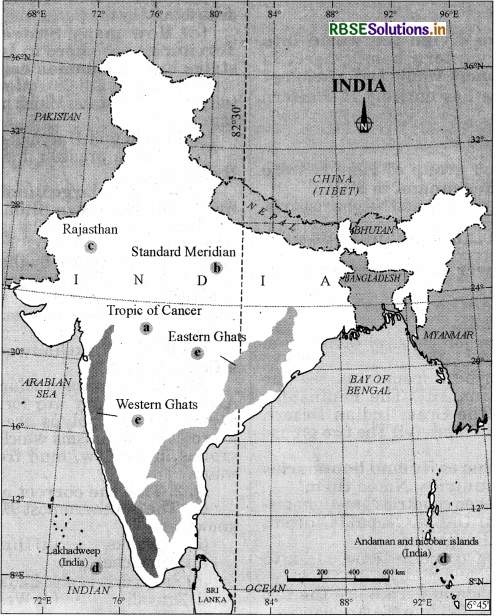RBSE Solutions for Class 6 Social Science Geography Chapter 7 Our Country - India
Rajasthan Board RBSE Solutions for Class 6 Social Science Geography Chapter 7 Our Country - India Textbook Exercise Questions and Answers.
RBSE Class 6 Social Science Solutions Geography Chapter 7 Our Country - India
RBSE Class 6 Social Science Our Country - India InText Questions and Answers
Page 47
Question 1.
If we divide the world into eastern and western hemisphere, in which hemisphere would India belong?
Answer:
India lies entirely in Eastern Hemisphere.
Page 54
Question 1.
Which group of islands were affected by the tsunami in 2004?
Answer:
The Andaman and Nicobar islands.

RBSE Class 6 Social Science Our Country - India Earth Textbook Questions and Answer
Question 1.
Answer the following questions briefly:
(a) Name the major physical divisions of India.
Answer:
The major physical divisions of India are
- The Northern mountains
- The Northern Plains
- The Peninsular Plateau
- The Great Indian Desert
- The Coastal Plains
- The two groups of Islands.
(b) India shares its land boundaries with seven countries. Name them.
Answer:
The seven countries are Afghanis-tan, Pakistan, China, Nepal, Bhutan, Myanmar and Bangladesh.
(c) Which two major rivers fall into the Arabian Sea?
Answer:
Narmada and Tapi are the two major rivers that fall into the Arabian Sea.
(d) Name the delta formed by the Ganga and the Brahmaputra.
Answer:
Sunderbans in West Bengal is the delta formed by the Ganga and Brahmaputra.
(e) How many States and Union Territories are there in India? Which states have a common capital?
Answer:
There are 28 states and 9 union territories. The states which have a common capital are:
- Punjab and Haryana-Chandigarh.
- Andhra pradesh and Telangana-Hyderabad.
(f) Why do a large number of people live in the Northern plains?
Answer:
The Northern plains are generally level and flat and formed by the alluvial deposits brought down by. the rivers Indus, Ganga and the Brahmaputra and their tributaries. It is a fertile land and that is why, large numbers of people live in the Northern plains.
(g) Why is Lakshadweep known as a Coral Island?
Answer:
Lakshadweep islands lie in the Arabian sea. They are formed of coral deposits. Coral polyps are short. Lived microscopic organisms which live in large groups in shallow, mud free and warm water.
Question 2.
Tick the correct answer:
(a) The southernmost Himalayas are known as
(i) Shiwaliks
(ii) Himadri
(iii) Himachal.
Answer:
(i) Shiwaliks
(b) Sahyadris is also known as
(i) Aravali
(ii) Western Ghats
(iii) Himadri.
Answer:
(ii) Western Ghats
(c) The Palk Strait lies between the coutnries
(i) Sri Lanka and Maldives.
(ii) India and Sri Lanka
(iii) India and Maldives.
Answer:
(ii) India and Sri Lanka
(d) The Indian islands in the Arabian Sea are known as
(i) Andaman and Nicobar Islands
(ii) Lakshaweep Islands
(iii) Maldives.
Answer:
(ii) Lakshaweep Islands
(e) The oldest mountain range in India is the
(i) Aravali hills
(ii) Western ghats
(iii) Himalayas.
Answer:
(i) Aravali hills
Question 3.
Fill in the blanks.
(a) India has an area of about
Answer:
3.28 million sq.km
(b) The Greater Himalayas are also known as
Answer:
Himadri
(c) The largest state in India in terms of area is
Answer:
Rajastha
(d) The river Narmada falls into the sea.
Answer:
Arabian
(e) The latitude that runs almost halfway through India is
Answer:
Tropic of Cancer.

Map Skills:
Question 4.
On an outline map of India, mark the following:
(a) Tropic of Cancer
(b) Standard Merdian of India
(c) State in which you live
(d) Andaman Islands and Lakshadweep Islands
(e) Western Ghats and Eastern Ghats

